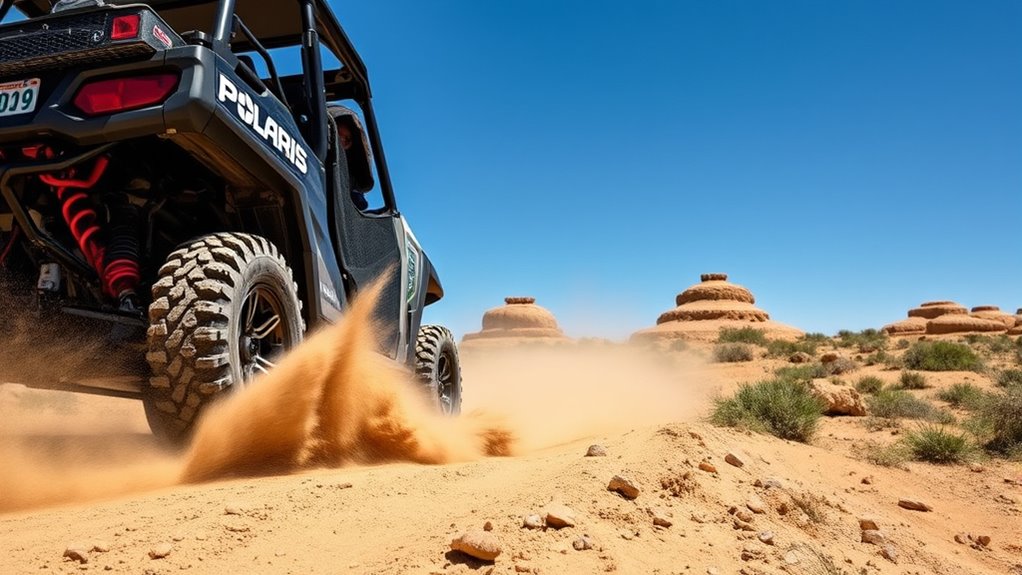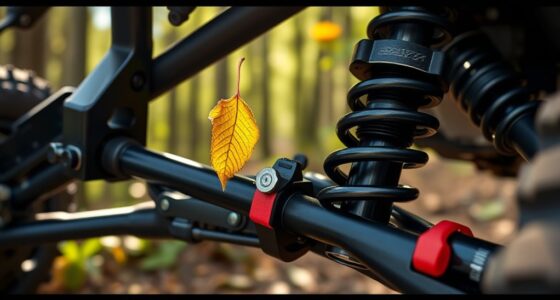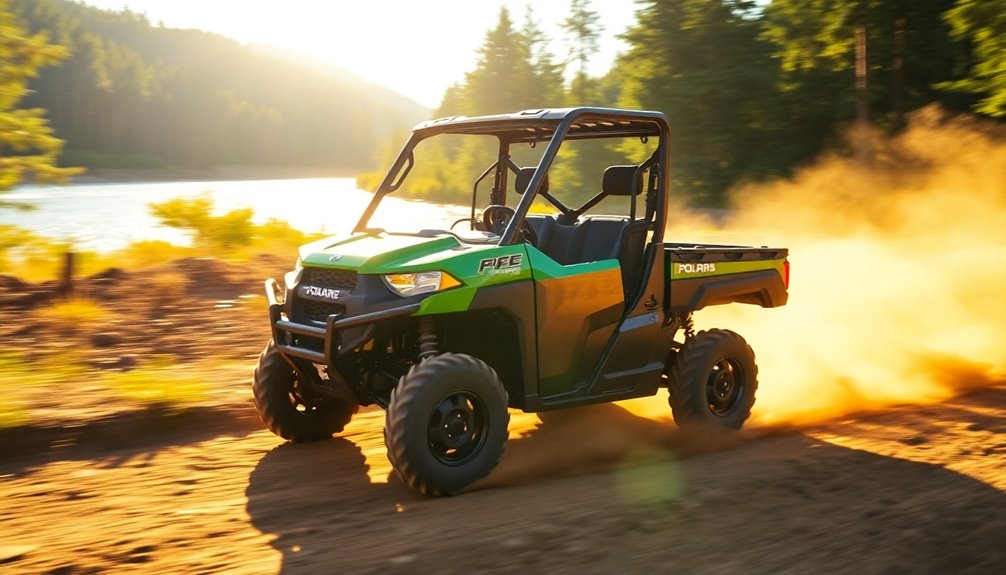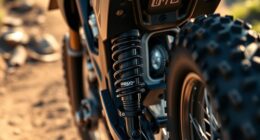To optimize your Polaris’s offroad performance, focus on proper weight distribution, tire pressure, and suspension setup. Maintaining even weight across all tires guarantees better traction and stability, especially on uneven terrain. Adjust tire pressure according to conditions to prevent slipping or bouncing, and fine-tune your suspension to absorb shocks and keep tires firmly in contact with the ground. Keeping these factors in check enhances control and safety—you’ll find it worthwhile to explore these adjustments further.
Key Takeaways
- Proper weight distribution enhances Polaris vehicle stability, traction, and handling on uneven offroad terrain.
- Tire pressure adjustments optimize contact patch and balance weight across all wheels.
- Suspension tuning absorbs shocks and maintains tire contact, improving weight transfer and control.
- Maintaining correct weight distribution prevents rollovers and improves safety during sharp turns and obstacles.
- Regular monitoring and adjustments ensure consistent performance tailored to terrain and load conditions.

Understanding weight distribution is vital when it comes to offroad vehicles like Polaris models, as it directly impacts stability, traction, and handling. When you’re traversing uneven terrain, how the weight is balanced across your vehicle can make the difference between a smooth ride and a dangerous slip or rollover. Proper weight distribution helps you maintain control, especially when climbing steep inclines or maneuvering through tight trails. To optimize this, you need to pay close attention to factors like tire pressure and suspension setup, which are key elements in managing how weight is distributed and how your vehicle responds to different conditions.
Proper weight distribution enhances Polaris stability, traction, and control on rough terrain.
Tire pressure plays a crucial role in managing weight distribution because it directly influences the contact patch between your tires and the ground. Under-inflated tires can cause more of the tire’s surface to touch the terrain, which may improve traction but can also lead to uneven wear and reduced stability if not properly managed. Over-inflated tires, on the other hand, reduce the contact patch, decreasing traction and making your vehicle more prone to bouncing or losing grip in rough terrain. You should regularly check and adjust tire pressure based on the terrain you’re tackling and the load you’re carrying. Proper tire pressure ensures that weight is evenly distributed across all tires, enhancing traction and stability, especially when carrying heavy loads or pulling equipment.
The suspension setup is another critical factor in achieving ideal weight distribution. A well-tuned suspension absorbs shocks from uneven ground, maintaining contact between the tires and terrain. If your suspension is too stiff, your Polaris might handle well on smooth surfaces but perform poorly on rugged trails, leading to a rough ride and uneven weight transfer. Conversely, if it’s too soft, you risk excessive body roll and decreased control. Adjusting your suspension components—such as shocks and springs—to match your typical riding conditions helps distribute weight more evenly across all wheels. This setup not only improves ride comfort but also ensures consistent traction, especially during sharp turns or when traversing obstacles. Additionally, wall organization systems can be used to keep essential tools and gear securely in place, preventing shifts that could affect weight balance during your ride.
In essence, understanding and managing weight distribution through tire pressure and suspension setup lets you maximize your Polaris’s capabilities. It’s about finding that perfect balance to enhance stability, traction, and handling regardless of terrain. Regular maintenance and adjustments are key; as conditions change, so should your approach to tire pressure and suspension tuning. With these factors in check, you’ll experience better control, safer rides, and more confidence when tackling the toughest offroad challenges.
Frequently Asked Questions
How Does Weight Distribution Affect Vehicle Handling?
Weight distribution directly impacts your vehicle’s handling by affecting the center of gravity and tire load. When weight is balanced, your vehicle stays stable, especially on uneven terrain. If the center of gravity shifts, it can cause you to lose control or tip over. Properly allocating weight ensures your tires carry equal load, improving traction and maneuverability. You’ll experience better control, safer rides, and enhanced offroad performance.
What Tools Are Best for Measuring Weight Distribution?
You should use a corner weight scale or portable wheel scales to measure weight distribution precisely. These tools help you determine the vehicle’s center of gravity and identify uneven weight. Suspension tuning tools are also essential, as they allow you to adjust shocks and springs to optimize handling. Regular measurements ensure your offroad vehicle maintains balanced weight, improving stability and performance during challenging terrains.
Can Weight Adjustments Improve Offroad Performance?
Yes, weight adjustments can considerably improve your offroad performance. By fine-tuning suspension settings, you can optimize weight distribution for better traction and stability on rough terrain. Additionally, adjusting tire pressure helps balance weight and improves grip, especially in challenging conditions. These small changes enhance handling, reduce strain on your vehicle, and make your offroad experience smoother and more controlled, giving you better confidence and performance during your adventures.
How Often Should Weight Distribution Be Checked?
Think of your vehicle as a balancing act on a tightrope; you need to check your weight distribution regularly. You should inspect it before each ride or every few outings, especially if you carry cargo or passengers. Proper weight distribution guarantees cargo stability and even tire wear, preventing accidents. By staying vigilant, you keep your offroad adventures safe and smooth, just like a tightrope walker maintaining perfect balance.
Does Weight Distribution Impact Fuel Efficiency?
Yes, weight distribution impacts your vehicle’s fuel economy because better vehicle balance reduces strain on the engine and drivetrain. When your offroad vehicle is properly balanced, it moves more efficiently, consuming less fuel. Poor weight distribution can cause uneven tire wear and increased resistance, leading to higher fuel consumption. To enhance fuel efficiency, regularly check and adjust your vehicle’s weight distribution, ensuring ideal balance during offroad adventures.
Conclusion
Understanding weight distribution in Polaris off-road vehicles is like mastering the art of balance on a tightrope—you stay steady and in control. By keeping weight properly distributed, you’ll enjoy smoother rides, better handling, and safer adventures. So, think of your vehicle as a well-orchestrated dance partner, moving gracefully over rough terrain. Embrace these principles, and you’ll navigate every trail with confidence and ease, turning every off-road trip into a ride worth remembering.








